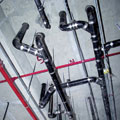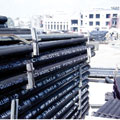
Charlotte Pipe and Foundry does
not recommend the use of plastics as a replacement for cast iron.
The trend toward value engineering in building construction has been underway for years. In the plumbing industry we have noted the practice of replacing originally specified cast-iron soil pipe and fittings with plastic drain, waste and vent (DWV) plumbing systems. The worst economy in 70 years tempts engineers, developers and contractors to look at this possibility to save every penny they can.
On the surface, value engineering may appear to be good business. Code restrictions on the use of plastic pipe and fittings have gradually diminished over time in certain model codes and local jurisdictions. And certainly there are appropriate applications where it makes economic sense to use plastic in place of cast iron – such as in tract home construction – because the purchase price of PVC DWV pipe and fittings can be significantly less than cast-iron pipe and fittings.
But in our estimation, the practice of value engineering within the industry has gone too far and as the president of a company that manufactures both plastic and cast-iron pipe and fittings, I feel an obligation to speak out.
There are applications whereCharlotte Pipe and Foundrywould not recommend the use of plastics as a replacement for cast iron – specifically in underground, commercial high-rise construction or high-end custom homes. Not only is it technically inappropriate in these applications, often it does not even make economic sense to switch.
While others argue plastics meet the minimum code standards, what meets code and what represents the best solution for high-performance buildings are two very different questions. When deciding whether to change a specification from cast iron to plastic, people too often overlook areas that canaddcost and complexity to a commercial project when installing plastics properly – areas such as fire-rated construction, sound attenuation, crush and deflection underground, thermal expansion and contraction, and hangers and supports.

As a cost-effective
solution, cast-iron piping can assist with fire-resistive construction.
Fire-Resistive Construction
Today’s high-rise commercial buildings are constructed with fire-rated separations to contain the spread of flame and smoke. The critical juncture for plumbers is when fire separations are penetrated with piping systems. For combustible materials such as plastic, these penetrationsmust be sealed back to the original fire integrity of the compartmentwith a fire-stopping system tested by a nationally recognized lab to ASTM E-814 Smoke and Flame Spread test.Being a thermoplastic, plastic piping will combust at 700º F, and will lose its structural integrity at just 250º, leaving an opening that will allow the spread of smoke and flame. To counter this, fire-stop materials are required to seal these penetrations. Installed in the space around the pipe, these materials expand when exposed to high heat.
A common fire-stopping assembly for plastic piping through concrete floors consists of a ring of intumescent material held in place around the pipe with a metal collar. This assembly involves shooting masonry anchors into the concrete, clamping the collar in place and installing a smoke seal with a bead of fire-resistant caulking.
The expected service life of these intumescent materials varies significantly by manufacturer. Some fire-stop manufacturers claim service life measured in decades, while some make no claims of an expected service life. Although a test method for aging of intumescent materials has been developed, there is no established method for using the results of these to calculate service life. As with any potentially life-saving product, these fire-stopping materials must be installed properly and tested and listed by an accredited third-party agency before use.
Cast-iron piping will not melt or burn away in a fire, meaning engineers can avoid the added cost and complexity of adding fire-stopping materials to their piping assemblies for every penetration in a building. All that is required to seal a cast-iron penetration is some mineral wool batting and fire-resistant caulking around the pipe, which makes the process simpler, faster and more cost effective. And the more floors and fixtures in the building, the greater the cost savings.

Cast-iron piping will not
melt or burn away in a fire.
Underground Installation
Proper underground piping installation is one of the most misunderstood piping applications. Underground piping is expected to support not only the earth load, but the live (traffic) load above it as well, all while limiting deflections or obstructions that can cause joint leaks. Cast-iron soil piping can handle these loads with no deflection. Defined as flexible systems, plastic piping will deflect if not properly installed. The point of failure for plastic pipe is deflection in excess of just 5% of the inner diameter of the pipe, according to the ASTM D 2321 standard – or only a quarter-inch for 4-inch pipe.With plastic installations, the sidefill stiffness of the trench is critical to support the pipe. For thermoplastic pipe, the trench is required to be the width of the pipe O.D. plus 16 inches or pipe O.D. times 1.25 plus 12 inches. For example, a 6-inch pipe would require a 20-inch-wide trench – that’s a lot of extra digging on the front end and extra compaction on the backfill. Compaction in 6-inch maximum layers – done by hand – is required by ASTM D2321. Depending on the soil type, minimum compaction density can range from 85% to 95%. Because cast iron is up to 10 times stronger than most thermoplastic materials, it does not need the compaction of the sidefill to support the pipe wall, so the trench can be as narrow as the installer wants.
Also, the plastic trench involves special bedding requirements – a minimum of 4 inches of material depending on the soil type to support the pipe. Cast iron requires no such bedding, only that the trench bottom be flat so that the pipe is uniformly supported. Again, a lot of extra work and materials when it comes to plastics.
Above Ground Installation
Above ground plastic DWV applications introduce a different set of issues that can add cost and complexity to high-rise commercial construction projects. For example, a lack of understanding of hanger requirements can lead to improper installations. Plastic must be supported by hangers every 4 feet in horizontal installations. Cast iron, on the other hand, needs only to be supported within 18 inches of each joint and every 10 feet. The cost of hangers, anchors, connectors and extra labor in a typical plastic installation can be up to 2½ times that of cast iron in horizontal applications.And unlike cast iron, plastic expands and contracts between swings in heat and cold. The rate of thermal expansion for plastic is approximately .36 inches per 100 feet of pipe for every 10 degrees F. Installing plastic in high-rise construction requires the use of expansion joints to accommodate these thermal effects.
One method for compensating for thermal expansion is to use an expansion coupling, which is a pipe-within-a-pipe that telescopes in and out as the piping expands and contracts. Expansion joints are required in vertical stacks at every other branch interval and on horizontal runs exceeding 20 feet – once again adding cost and complexity to the system. And expansion joints can create headaches during water testing of the system because they can leak if not properly installed.

Roddey
Dowd Jr.
Creating A Quiet System
With fire-resistive construction or underground installations, the differences between plastic and cast iron are hidden from view. But there’s no hiding the differences in sound attenuation capabilities in above ground installations. Simply put – there is no piping system that is quieter than cast iron.No one wants to hear the gurgling and sloshing sounds of water from fixtures on floors above flowing down the walls, especially in high-rise condominiums, commercial office buildings or high-end hotels. Using cast iron for waste piping will result in a plumbing system that is twice as quiet compared to an all-plastic system.
Density is the primary factor in the sound-dampening quality of cast iron. Cast iron is significantly more dense than plastic. But density isn’t cast iron’s only advantage when it comes to noise. The method of joining sections of pipe together also plays a key role.
The neoprene gaskets used in cast-iron installations keep each section of pipe from touching, thus eliminating any contact-related sound. Plastic systems are solvent cemented into rigid systems that can create noise as they expand and contract with heating and cooling.
Some “fixes” that plumbers attempt to solve plastics noise problems may not actually fix the problem. Wrapping plastic pipe in insulation to muffle the sound of water cascading through the pipe means additional time and materials.
Cast-iron plumbing systems have been in use for centuries. Cast iron is reliable, durable and easy for a skilled tradesman to install. All too often we have seen piping systems value engineered to plastics because of the upfront costs associated with cast iron. But, as you can see, the added steps and considerations involved in installing plastic can actuallyaddtechnical complexity, cost and liability to a project, thus eliminating any upfront savings in material costs.
In our business, we see the negative consequences and large liabilities created by value engineering and poor craftsmanship. In my own condominium in Charlotte, the underground PVC waste line to the city service failed due to deflection and had to be ripped out after raw sewage backed up and flooded the ground-floor units. The line was replaced with service cast iron and is functioning fine.
Instead of always racing to the bottom, perhaps it’s time we step back and start using the correct materials for the installation – not ones that can create unintended mishaps down the road.
Photos courtesy of Charlotte Pipe and Foundry.
